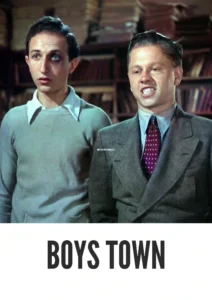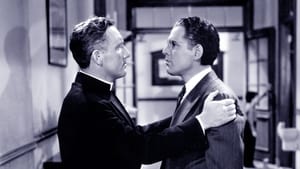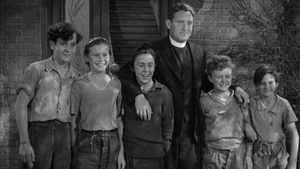Contact: info@alwanfilm.com
Video Sources 0 Views

Synopsis
Review: Boys Town 1938 Colorized – A Timeless Tale of Hope and Redemption

Introduction
“Boys Town 1938” is a cinematic gem that continues to resonate with audiences decades after its release. Directed by Norman Taurog, this classic film tells the inspiring story of Father Edward J. Flanagan and his efforts to create a sanctuary for troubled boys. In this article, we will delve into the significance of “Boys Town 1938,” exploring its heartfelt narrative, stellar performances, and lasting impact on both cinema and society.
Check The Full Colorized Movies List
Check Our Colorized Movies Trailer Channel
Understanding Boys Town 1938: Director, Cast, and Genre
“Boys Town 1938” was brought to life by the accomplished director Norman Taurog, whose deft touch brought both warmth and gravity to the film. The movie stars Spencer Tracy in the role of Father Flanagan, delivering a performance that won him the Academy Award for Best Actor. Alongside Tracy, Mickey Rooney shines as Whitey Marsh, a rebellious youth who finds redemption under Father Flanagan’s guidance.
This film falls within the drama genre, though its emotional depth and inspirational message set it apart as a unique and timeless work. Taurog’s vision for “Boys Town” was to create a film that not only entertained but also conveyed a powerful social message about the importance of compassion and community.
Exploring the World of Boys Town 1938: Plot and Characters
The plot of “Boys Town 1938” is centered around Father Edward J. Flanagan, a real-life priest who founded Boys Town, a home for homeless and delinquent boys in Omaha, Nebraska. The film begins with Flanagan’s unwavering belief that “there’s no such thing as a bad boy” and follows his struggles and triumphs in establishing Boys Town.
One of the film’s most memorable characters is Whitey Marsh, played by Mickey Rooney. Whitey is a tough, street-smart kid with a chip on his shoulder, whose arrival at Boys Town challenges Father Flanagan’s patience and faith. The dynamic between Flanagan and Whitey forms the heart of the film, showcasing the transformative power of kindness and understanding.
The Art of Film Colorization
Film colorization involves adding color to black and white footage, a process that has evolved significantly over the years. Initially, colorization was done by hand, frame by frame, which was time-consuming and often resulted in inconsistent quality. Modern techniques use digital technology to achieve more seamless and realistic results.
Colorization can offer a new dimension to classic films, making them more accessible and visually appealing to contemporary audiences. However, it also raises questions about artistic integrity and historical authenticity, as the original creators’ visions were in black and white.
Early Colored Films: A Brief History
The advent of color in cinema dates back to the early 20th century, with techniques like hand-tinting and two-color Technicolor. These early experiments paved the way for the full Technicolor process, which became popular in the 1930s and revolutionized the film industry. Films like “The Wizard of Oz” and “Gone with the Wind” showcased the stunning possibilities of color on the big screen.
Color films offered a new way to engage audiences, enhancing the storytelling experience with vibrant visuals. Despite the excitement surrounding color films, many filmmakers continued to use black and white to achieve specific artistic effects, as seen in classics like “Citizen Kane” and “Psycho.”
Boys Town 1938 and Its Early Colored Version
The decision to release “Boys Town 1938” in a colorized format allows modern viewers to experience this classic film in a new light. While the original black and white version remains a testament to the era’s cinematic techniques, the colorized version offers a fresh perspective, highlighting details and emotions that might have been overlooked.
The colorization of “Boys Town 1938” brings a new vibrancy to the film, making the characters and settings feel more immediate and real. This can enhance the emotional impact of the story, allowing contemporary audiences to connect more deeply with the film’s message of hope and redemption.
The Debate Over Film Colorization
The colorization of black and white films has been a topic of debate for decades. Supporters argue that colorization makes classic films more accessible to younger audiences, who might be less inclined to watch black and white movies. They also contend that color can enhance the storytelling experience, bringing new life to old films.
Opponents of colorization argue that it can distort the original artistic vision of the filmmakers. Black and white cinematography is a deliberate artistic choice, and altering it can change the mood and tone of a film. Additionally, there are concerns about historical authenticity, as colorized films may not accurately represent the time period in which they were made.
Examining Boys Town 1938 as an Early Colored Film
Viewing “Boys Town 1938” in its colorized form provides an interesting case study in the effects of colorization on classic films. The added color brings a new dimension to the film’s visual storytelling, highlighting the contrast between the bleakness of the boys’ troubled pasts and the hopeful environment of Boys Town.
Colorization can enhance the emotional resonance of key scenes, such as the warm, inviting interiors of Boys Town or the vibrant landscapes that symbolize new beginnings. However, it also raises questions about the preservation of the film’s original aesthetic and the intentions of its creators.
Influence and Legacy: Boys Town 1938 Colorized’s Impact on Cinema
“Boys Town 1938” has left a lasting legacy on both cinema and society. The film’s success helped to raise awareness about the plight of homeless and delinquent boys, inspiring real-world efforts to support at-risk youth. Father Flanagan’s work continues to this day, with Boys Town still operating as a haven for children in need.
In terms of its cinematic influence, “Boys Town 1938” set a precedent for films that combine social commentary with heartfelt storytelling. It demonstrated the power of cinema to effect positive change and inspire audiences, paving the way for future socially conscious films.
Director’s Cinematic Legacy: Beyond Boys Town 1938 Colorized
Norman Taurog’s career extended far beyond “Boys Town 1938,” with a diverse body of work that includes comedies, musicals, and dramas. Taurog won an Academy Award for Best Director for “Skippy” in 1931, making him the youngest person to ever receive the honor, a record he still holds.
Taurog’s ability to elicit powerful performances from his actors and his knack for blending humor with pathos made him a versatile and respected director. His films, including the “Boys Town” sequel “Men of Boys Town” (1941), continued to explore themes of resilience, community, and compassion.
Themes Explored in Boys Town 1938 Colorized
“Boys Town 1938” delves into themes of hope, redemption, and the transformative power of compassion. The film’s central message, encapsulated in Father Flanagan’s belief that “there’s no such thing as a bad boy,” challenges viewers to reconsider their assumptions about human nature and the potential for change.
The story also explores the importance of community and support systems in helping individuals overcome adversity. Boys Town serves as a microcosm of an ideal society, where everyone is given a second chance and the opportunity to thrive. The film’s portrayal of Flanagan’s unwavering faith in the goodness of others remains inspiring to this day.
Reception and Controversy Surrounding Boys Town 1938 Colorized
Upon its release, “Boys Town 1938” was met with critical acclaim and commercial success. Spencer Tracy’s portrayal of Father Flanagan was widely praised, earning him an Academy Award for Best Actor. The film’s heartfelt story and strong performances resonated with audiences, solidifying its place as a classic of American cinema.
However, like many films of its time, “Boys Town 1938” is not without its controversies. Some critics have noted that the film’s portrayal of troubled youth is somewhat idealized, glossing over the more complex and systemic issues facing at-risk children. Additionally, the film’s depiction of race and ethnicity reflects the biases and limitations of its era, which may be jarring to contemporary viewers.
Where to Watch Boys Town 1938 Colorized Online
For those eager to experience the timeless brilliance of “Boys Town 1938,” the film is available on various streaming platforms, ensuring accessibility to audiences worldwide. Services such as Amazon Prime Video, iTunes, and Turner Classic Movies offer both the original black and white version and the colorized rendition.
Watching “Boys Town 1938” online provides an opportunity to revisit this classic film and appreciate its enduring themes of hope and redemption. Whether in its original format or the colorized version, the film continues to inspire and uplift viewers.
FAQs About Boys Town 1938 Colorized
Common queries surrounding “Boys Town 1938” range from its historical accuracy to its cultural impact. By addressing these frequently asked questions, viewers can gain a deeper understanding of the film’s enduring appeal and significance.
Q: Is “Boys Town 1938” based on a true story?
A: Yes, the film is based on the real-life story of Father Edward J. Flanagan and his efforts to establish Boys Town, a home for homeless and delinquent boys in Omaha, Nebraska.
Q: Did Spencer Tracy really win an Oscar for his role in “Boys Town 1938”?
A: Yes, Spencer Tracy won the Academy Award for Best Actor for his portrayal of Father Flanagan in “Boys Town 1938.” His performance is widely regarded as one of the highlights of his illustrious career.
Q: What impact did “Boys Town 1938” have on the real Boys Town?
A: The success of the film helped to raise awareness and support for Boys Town, contributing to its growth and development. Father Flanagan’s work continues to this day, with Boys Town serving as a beacon of hope for children in need.
Conclusion
In conclusion, “Boys Town 1938” remains a timeless classic that continues to inspire and uplift audiences with its powerful message of hope and redemption. While the early colored version offers a fresh perspective on this beloved film, the original black and white presentation retains its historical and artistic significance.
Whether viewed in color or monochrome, “Boys Town 1938” stands as a testament to the enduring power of compassion, community, and the belief that every boy deserves a chance to succeed. As we continue to navigate the ever-changing landscape of cinema, let us honor the legacy of “Boys Town 1938” and the visionary work of Norman Taurog and Father Flanagan, whose contributions to film and society remain profoundly impactful to this day.












